KySat-1 (Kentucky Satellite-1)
Non-EO
Education
Technology and Research
Quick facts
Overview
| Mission type | Non-EO |
| Launch date | 04 Mar 2011 |
| End of life date | 04 Mar 2011 |
KySat-1 (Kentucky Satellite-1)
KySat-1 is a CubeSat developed by college students across the state of Kentucky in a collaborative effort. The newly founded partnership is referred to as the Kentucky Space Consortium (KSC), a non-profit enterprise involving universities (6), and public and private organizations. The Kentucky Space Consortium, or simply Kentucky Space, was founded in early 2006 (based in Lexington, KY). The primary mission objective of the project is to interest K-12 students in the fields of science, technology, engineering, and mathematics. 1) 2)
The Universities involved in this partnership are: University of Kentucky, Murray State University, Morehead State University, KCTCS (Kentucky Community & Technical College System), University of Louisville, and Western Kentucky University.
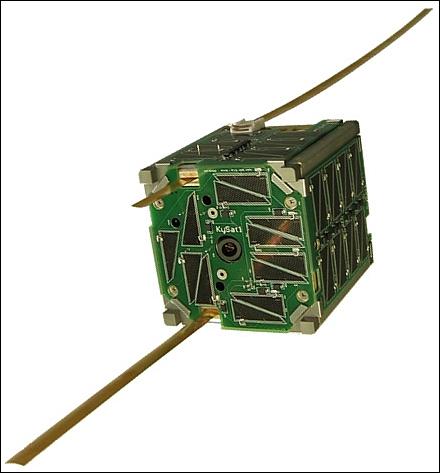
Once on orbit, KySat-1 will be made available at no cost to Kentucky schools, students, teachers, and parents for educational purposes and applications. While the primary mission of KySat-1 is educational outreach, the goals of the Kentucky Space program also include creating educational experience for secondary and post secondary students, cultivating an aerospace and satellite technology base in Kentucky, and developing a reliable and reusable satellite bus that will form the basis for future education and commercial satellite missions. 3)
Spacecraft
The spacecraft conforms to the CubeSat standards with a bus size of 10 cm x 10 cm x 10 cm and a mass of ≤ 1 kg. The satellite system consists of the spacecraft bus, spacecraft payloads, mechanical structure, ground station, and flight software. 4) 5)
The internal bus hardware consists primarily of five PCBs (Printed Circuit Boards); the processor module, the power module, the system support module, the payload interface module, and the UHF/VHF radio module.
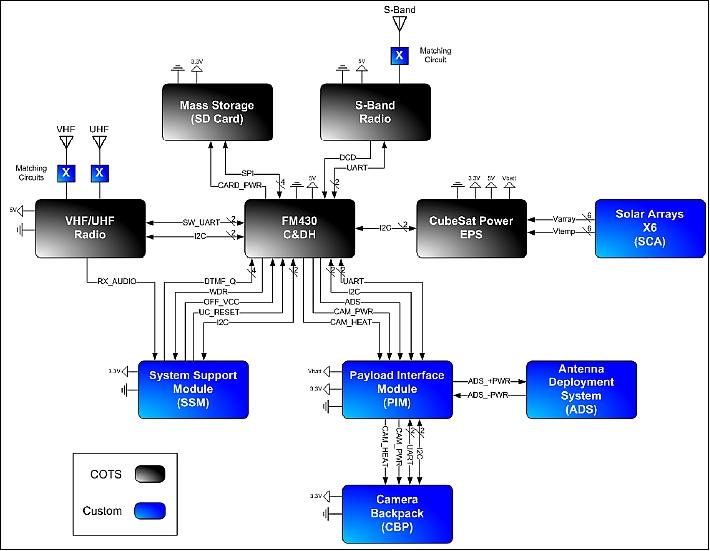
The OBC or flight computer employs a processor module of Pumpkin Inc., containing the MSP430-F1611 microcontroller (16 bit) of Texas Instruments. The unit contains two serial communication interfaces that can be configured to operate as UART (Universal Asynchronous Receiver/Transmitter), SPI (Serial Peripheral Interface), or I2C (Inter-Integrated Communication) bus. Two 12 bit DACs (Digital Analog Converters) and eight 12 bit ADCs are also contained within the chip to provide analog functionality.
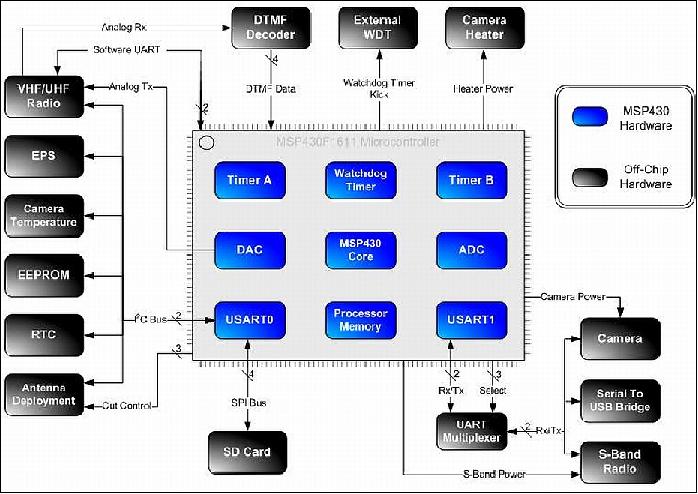
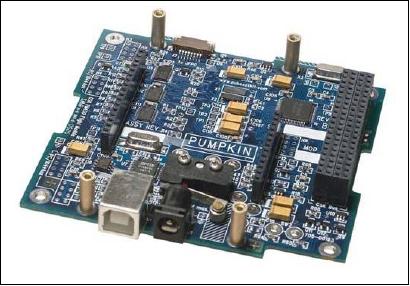
EPS (Electrical Power Subsystem): Power control within the satellite is accomplished by a "CubeSat power module" from Clyde Space Ltd. This single circuit board provides the connectors to up to six solar panels, the battery, charging circuitry, battery temperature control, and 3.3 and 5 volt high-efficiency switching regulators. A monitoring processor and individual rail power on/off control is achieved through an I2C interface. The face-mounted solar panels interface to dedicated converters that allow for multiple voltages to be accepted from the solar panels. An 8.4 volt lithium-polymer battery with a BOL (Beginning of Life) capacity of 7.2 Whr is also part of this system. The EPS features over-current and low battery voltage protection on the three power rails and is capable of supplying many telemetry points (housekeeping data) including currents, voltages, temperatures, and estimated battery charge state.
The solar arrays are based on a low-cost individual cells with advanced performance (triple-junction GaAs design with 27% efficiency, SpectroLab's TASC cells).
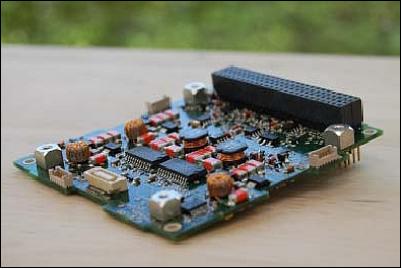
SSM (System Support Module): The SSM, PIM, and all the solar boards are custom designed. The power switches and headers for the antenna deployment and camera are on the PIM. The SSM function is to provide support to the processor module and other systems throughout the satellite. It includes a real time clock, a watch dog timer, a DTMF (Dual-Tone Multifrequency) receiver, a supervisory microcontroller, high current switches for antenna deployment, as well as header and power control switches for the camera payload and the antenna deployment mechanism.
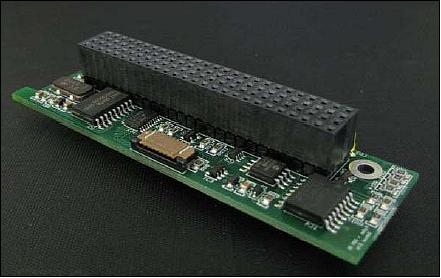
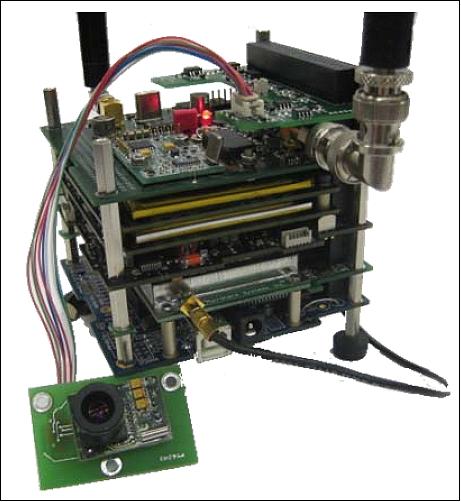
RF communications: The satellite system has two transceivers: UHF/VHF and S-band.
• An amateur band VHF/UHF (uplink/downlink) radio is being used. This module supports the sending and receiving TNCs (Terminal Node Controllers) and modulator/demodulators, conforming to the AX.25 protocol specifications, a RF transmitter, a RF amplifier, and a RF receiver. Data rates of 1200 baud are supported in uplink and downlink. KySat-1 has three antennas, all of which are mounted orthogonal to one plane (Figure 1).
• The S-band system (secondary communication system) used is the MHX2400 spread spectrum device manufactured by Microhard Systems with a mass of 75 gram. The system operates at 5 V and consumes 200 mA and 700 mA for Rx and Tx, respectively. Like the camera, the power supply to the S-band link will be completely cut when it is not in use. The S-band data rates are 2400 to 115.2 kbaud.
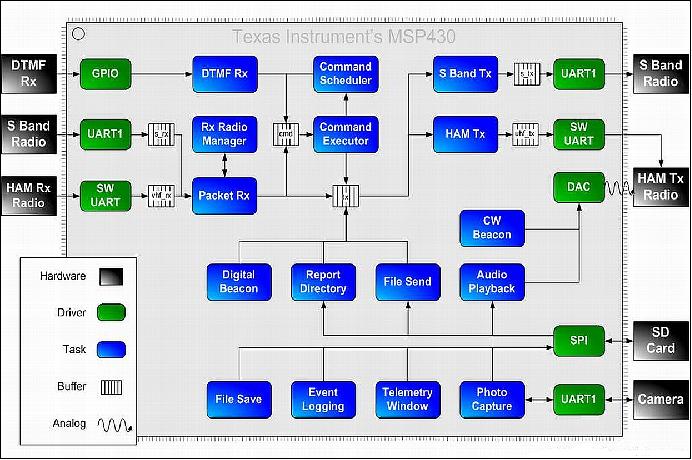
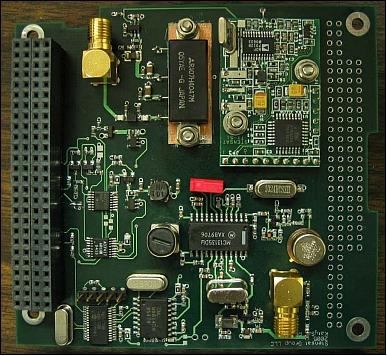
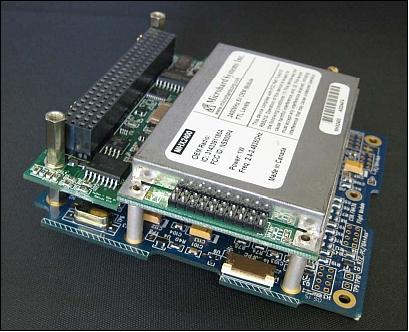
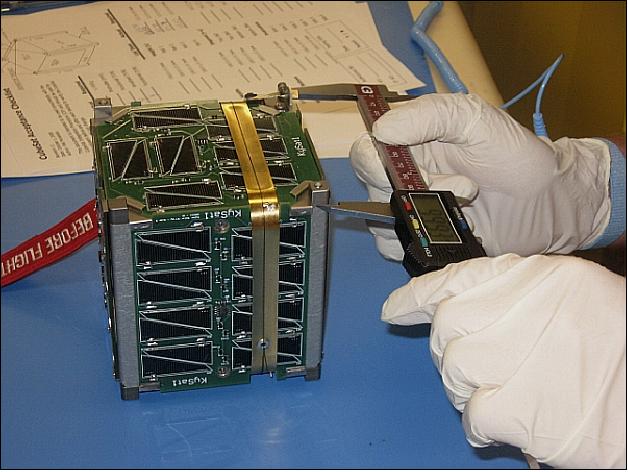
Launch
KySat-1 is part of the ELaNa (Educational Launch of Nanosatellites) initiative of NASA with two other CubeSats: HERMES (University of Colorado at Boulder), Explorer 1 PRIME (E1P) of Montana State University. 6)
The primary payload on the flight is the Glory mission of NASA. The Glory spacecraft was launched on March 4, 2011 on a Taurus-3110 vehicle of OSC from VAFB, CA.
Unfortunately, the launch of the Glory spacecraft, along with the three secondary payloads, failed to reach orbit and ended in the Pacific Ocean. Telemetry indicated the fairing, the protective shell atop the Taurus XL rocket, did not separate as expected about three minutes after launch. NASA has begun the process of creating a Mishap Investigation Board to evaluate the cause of the failure. 7)
Orbit: Sun-synchronous circular orbit, altitude = 705 km, inclination = 98.2º.
The KySat-1 antenna mounting plane is located between the launch rails of the P-POD (Poly-Picosatellite Orbital Deployer - the standardized deployer system of CalPoly) where an additional 6.5 mm of clearance is allowed on each side of the CubeSat (this is in addition to the standard “maximum” 10 x 10 x 10cm CubeSat measurements). In the stowed configuration the longest antenna will be wrapped closely around the exterior of the satellite and will thus hold the remaining shorter stowed antennas beneath it.
Ground Segment
Although the KySat-1 communication's subsystem provides the satellite with the ability to downlink data to and receive commands from many different UHF/VHF ground stations, the primary ground station of KySat-1 is located at the Space Science Center at Morehead State University (MSU), located in Morehead, Kentucky. MSU's 21 m SPA (Space Tracking Antenna) will be used to support the KySat-1 S-band mission.
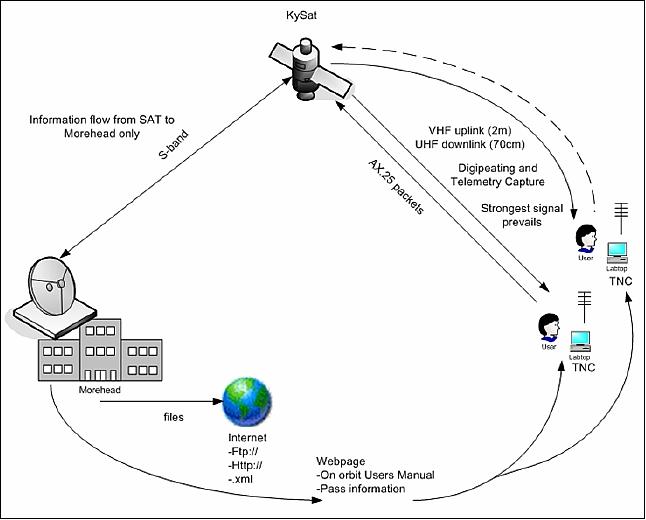
Sensor Complement
COTS Camera
A low-mass COTS camera, the C328-7640 from CO Media was selected. The device has a mass of ~ 5 gram and is capable of producing both JPEG compressed images and uncompressed bitmaps at a range of resolutions from VGA (640 x 480) to 80 x 64. It is directly compatible with the power system on the spacecraft requiring a supply of 3.3 V and consumes 60 mA.
Since KySat is not actively stabilized, provisions have been implemented in the S/C software to assist in ensuring that valuable images are received from the satellite. Upon capturing each frame, the image will be requested from the compression engine at four different resolutions (640 x 480, 320 x 240, 160 x 128, and 80 x 64) and stored on the SD (Secure Digital) flash card. Employing this method, one can quickly download the smaller image to manually determine if it is worth committing the transmission time required to get larger versions.
References
1) Tyler J. Doering, “KySat-1 Status, Lessons Learned,” CubeSat Developers’ Workshop, San Luis Obispo, CA, April 11, 2008, URL: http://mstl.atl.calpoly.edu/~workshop/archive/2008/Spring/Day%203/1040%20-%20Doering%20-%20KySat.pdf
2) http://kysat.typepad.com/my_weblog/2009/04/kysat-1-has-reached-another-major-milestone-on-monday-april-20-the-kysat
-1-engineering-model-underwent-a-fully-integrated.html
3) Colorado Space Grant Consortium, Kentucky Space, Montana State University, “NASA’s ELaNaProgram and it’s First CubeSat Mission,” Portland, ME, USA, Oct. 14-16,, 2010, URL: http://national.spacegrant.org/meetings/presentations/2010_Fall/19.pdf
4) Garrett D. Chandler, Dale T. McClure, Samuel F. Hishmeh, James E. Lumpp, Jr., Jennifer B. Carter, Benjamin K. Malphrus, Daniel M. Erb, William C. Hutchison, III, Gregory R. Strickler, James W. Cutler, Robert J. Twiggs, “Development of an Off-the-Shelf Bus for Small Satellites,” Proceedings of the 2007 IEEE Aerospace Conference, Big Sky Montana, March 3 - 10, 2007
5) Samuel F. Hishmeh, Tyler J. Doering, James E. Lumpp, Jr., “Design of Flight Software for the KySat CubeSat Bus,” Proceedings of the 2009 IEEE Aerospace Conference, Big Sky, MT, USA, March 7-14, 2009
6) Garrett L. Skrobot, “Project ElaNa and NASA’s CubeSat Initiative,” Proceedings of the CalPoly 2010 CubeSat Developer's Workshop, San Luis Obispo, CA, USA, April 21-23, 2010, URL: http://cubesat.calpoly.edu/images/cubesat/presentations/DevelopersWorkshop2010/1...
7) NASA's Glory Spacecraft Launches, Fails To Reach Orbit,” March 4, 2011, URL: http://glory.gsfc.nasa.gov/launch.html
8) Tyler J. Doering, “The Kentucky Space Consortium, 2008 4th Quarter Update,” 5th Annual Developer’s Workshop AIAA/USU Small Satellite Conference, Logan, UT, USA, August 8, 2008
The information compiled and edited in this article was provided by Herbert J. Kramer from his documentation of: ”Observation of the Earth and Its Environment: Survey of Missions and Sensors” (Springer Verlag) as well as many other sources after the publication of the 4th edition in 2002. - Comments and corrections to this article are always welcome for further updates (eoportal@symbios.space).